AI SEO Agency: The Complete Guide to SEO, GEO & AEO
Ballistic Content Team

The world of website building has never been more accessible—or more overwhelming. With countless tools promising drag-and-drop simplicity or pixel-perfect control, business owners, marketers, and creatives alike often find themselves stuck at the very first question: Which platform should I choose? In 2025, that question almost always narrows down to a final face-off—Webflow vs Wix.
On the surface, both Webflow and Wix offer similar promises: code-free site building, beautiful templates, e-commerce capabilities, and scalability. But under the hood, they’re fundamentally different beasts. One is laser-focused on customization and developer-grade precision, while the other champions speed and convenience, especially for beginners and small business owners.
According to Statista and W3Techs, Wix holds approximately 13% of the global website builder market, supported by a massive user base of over 260 million registered users across 190+ countries. In contrast, Webflow powers about 0.8% of all websites and 1.2% of CMS-driven sites as of mid-2025. Despite its smaller market share, Webflow is quickly gaining traction among professional designers, creative agencies, and fast-growing startups, with over 3.5 million total users and 45,000 paying customers.
So, how do you choose between the two? This comprehensive comparison will dissect the major differences across design capabilities, performance, SEO, e-commerce, pricing, and much more. Whether you’re a solo entrepreneur launching your first online portfolio or an agency managing multiple client projects, this guide will help you navigate the maze and land on the right platform.
Let’s dive in and explore what truly sets Webflow and Wix apart—and why that difference matters more in 2025 than ever before.
When it comes to choosing the right website builder, ease of use is often the make-or-break factor—especially for beginners or small teams without dedicated developers. Between Webflow and Wix, the user experience couldn’t be more different. One favors rapid deployment, the other demands patience but rewards power.
Wix has always prioritized simplicity. Its interface is intuitive, visually driven, and extremely beginner-friendly. As soon as you sign up, Wix offers two clear paths: choose from over 900 designer-made templates or let Wix ADI (Artificial Design Intelligence) build a custom website for you based on a few prompts. You could literally go from blank screen to published website in under an hour.
This efficiency makes Wix an appealing option for small business owners, solopreneurs, and anyone who wants to skip the learning curve. Features like drag-and-drop editing, pre-built content blocks, and a WYSIWYG (What You See Is What You Get) interface mean there’s no coding required, ever. According to UserGuiding's 2025 overview, users can launch a basic Wix site in less than 30 minutes—a huge selling point for those who value speed.
Webflow, on the other hand, is often described as a hybrid between a website builder and a professional design tool like Adobe XD or Figma. It’s not designed to be intuitive from day one, but rather to give users full control over their layout, structure, and styling. In other words, Webflow assumes that you either know a bit about web design or are willing to learn.
The interface is detailed and rich with functionality. You can define CSS properties, build complex interactions, and manage reusable components—all visually, without writing a line of code. But you’ll need to understand how elements behave in HTML and CSS to avoid confusion. That’s why Webflow University, their vast library of tutorials and walkthroughs, is practically a prerequisite for new users.
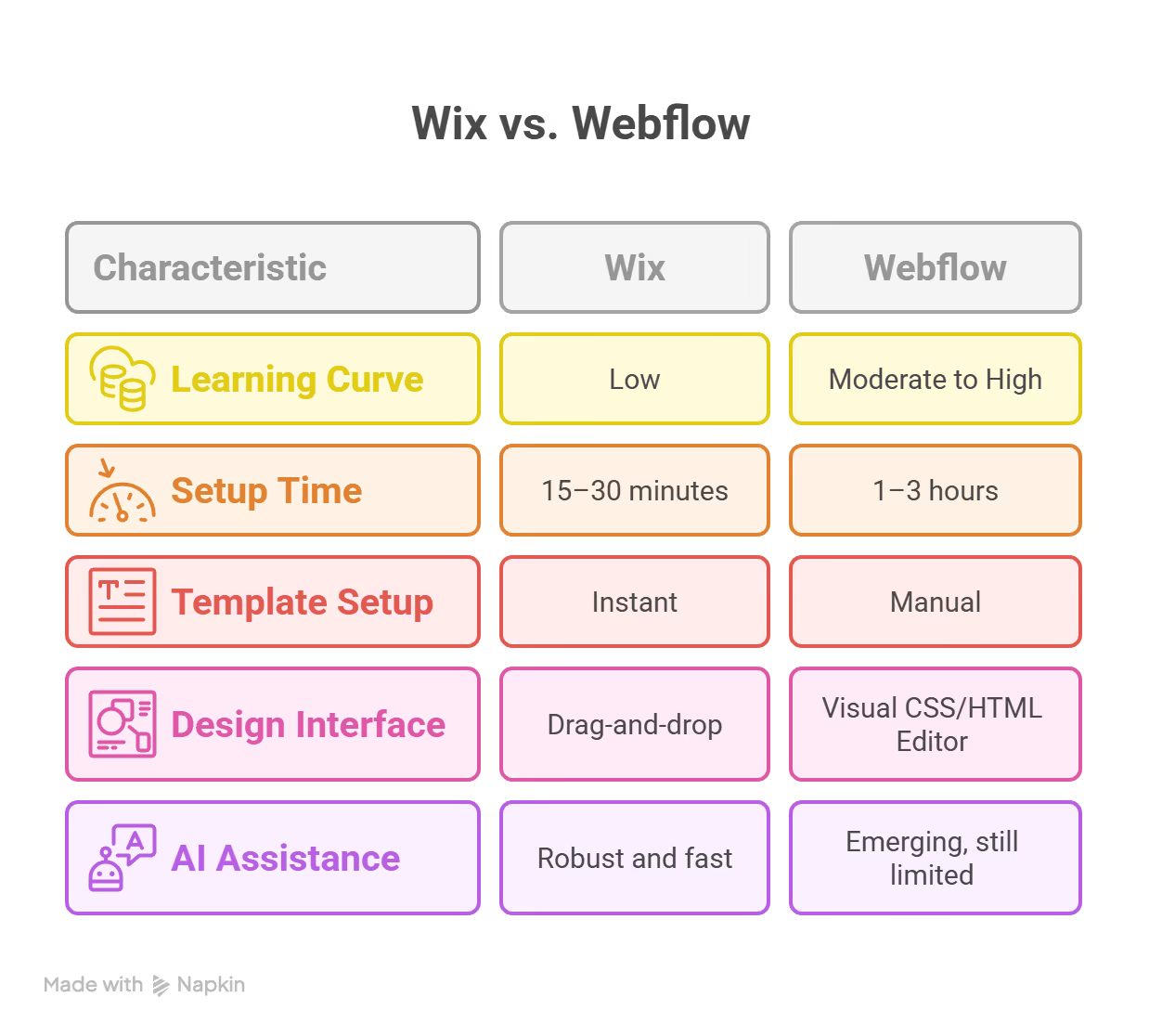
If you need a professional-looking website online as quickly as possible—with minimal fuss—Wix is the clear winner. But if you value control, precision, and are willing to invest the time to learn, Webflow offers a depth of customization that Wix simply can’t match.
Design isn’t just about making your site look good—it’s about creating an experience. And in today’s digital-first world, your website is often your first impression. So, when comparing Webflow vs Wix, the design flexibility each platform offers becomes a critical factor.
Wix offers over 900 pre-designed templates, each optimized for different industries—from salons to photographers to SaaS startups. These templates are plug-and-play, which means users can start customizing immediately by swapping in content, images, and branding.
What makes Wix especially appealing is its drag-and-drop editor, which allows you to move, resize, and style elements visually. You don’t need to understand layout principles or CSS grids—Wix takes care of it behind the scenes. This ease of use, however, comes with trade-offs. Once you choose a template, you can’t switch to another without rebuilding the entire site from scratch. And while Wix Studio introduces more advanced design tools like custom CSS and AI-powered responsive layouts, it still doesn’t match the granular control Webflow offers.
Wix also provides a handful of animations and interactions, but they are relatively basic. If your design needs go beyond fades and slides, you’ll start to hit a ceiling quickly.
Webflow flips the paradigm. Rather than offering pre-built templates as a shortcut, it empowers you to design from scratch, replicating the kind of precision you’d expect from tools like Sketch or Figma—except this time, your designs are instantly live on the web.
With Webflow, you have full control over every pixel, margin, and breakpoint. Want a sticky header that fades in with scroll-based animation? No problem. Need to customize hover states on every clickable element? Done. The platform uses the same core principles as frontend development—HTML, CSS, and JavaScript—but abstracts them into a visual editor.
And while that complexity may seem daunting, the payoff is real: Webflow websites are renowned for their sophistication and uniqueness. Features like Lottie animations, reusable components, and flexbox or grid-based layouts allow you to build immersive, responsive designs with professional polish.
Case in point: The Flux Academy homepage, built entirely in Webflow, features smooth scroll interactions and responsive animations that would take weeks to develop by hand in code. With Webflow, these elements can be visually configured—no developer needed.
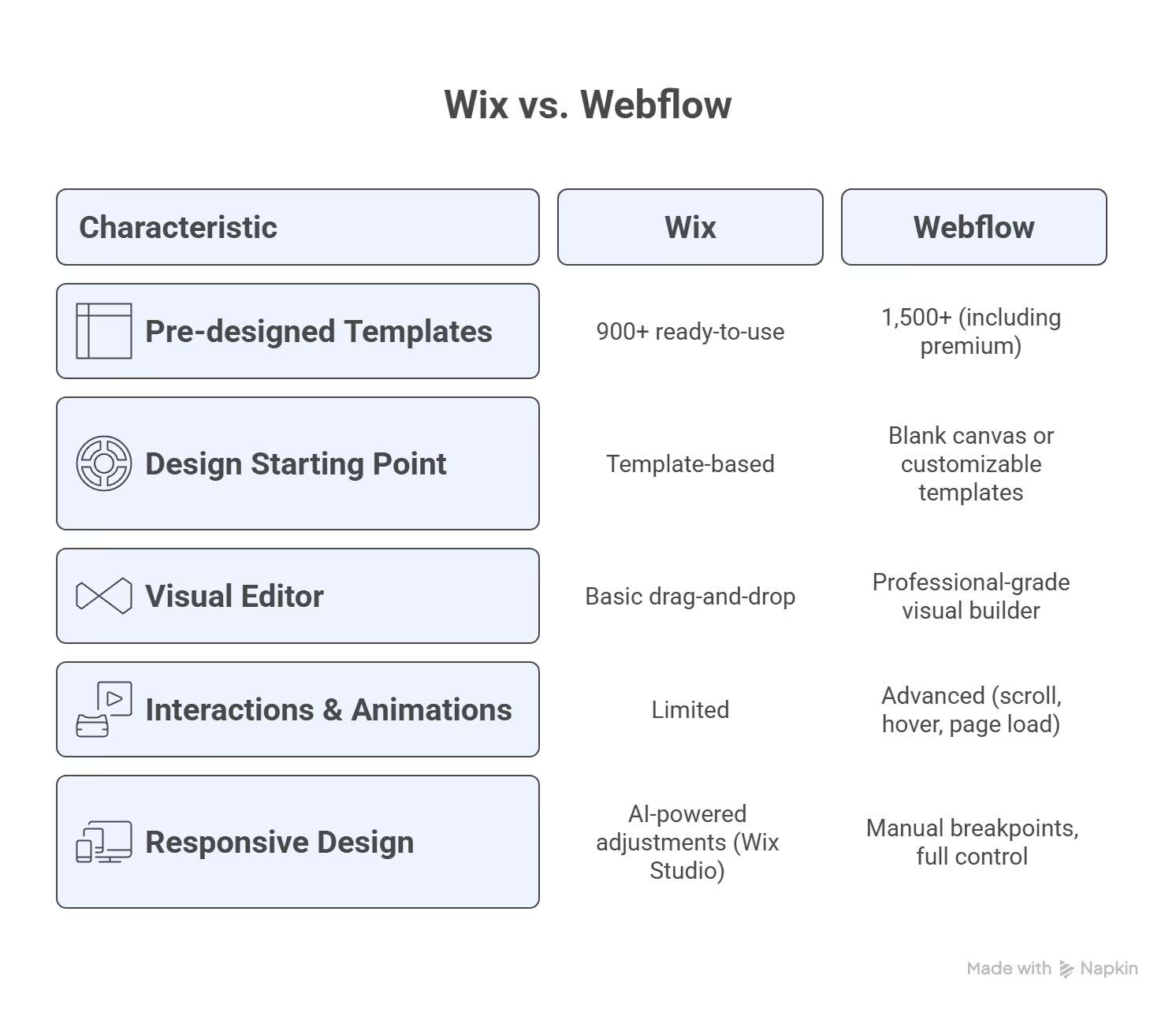
If you're building a simple brochure site and want to launch quickly, Wix gives you the tools to get there without much fuss. But if you’re a creative professional, agency, or startup looking to push design boundaries and create unique, on-brand experiences, Webflow is the superior choice—hands down.
A visually stunning website means little if it loads slowly or performs poorly on mobile. In fact, according to Google's research, 53% of users will abandon a site if it takes longer than three seconds to load. That’s why performance is more than a technicality—it’s a conversion factor.
So how do Webflow and Wix stack up when it comes to speed and technical efficiency?
Wix has made significant improvements over the years in performance. It now offers features like automatic image optimization, lazy loading, and a built-in CDN (Content Delivery Network) to improve page load times across the globe. However, performance can still vary depending on how you use the platform.
The ease of drag-and-drop editing and app integrations sometimes leads to bloated code, especially when users pile on third-party widgets or animations. This can affect Time to Interactive (TTI) and Largest Contentful Paint (LCP)—both of which are key Core Web Vitals measured by Google.
On mobile, Wix performs well in controlled tests but can lag behind if you use complex layouts or custom elements. And although Wix Studio introduces smarter responsive behavior, you don’t get fine-grained control over performance elements like you do in Webflow.
Webflow takes a very different approach. Because it uses clean, semantic HTML5, CSS3, and JavaScript, the websites you build are lean and performant by default. Every design decision you make in Webflow is translated into developer-grade code, meaning fewer dependencies and more predictable rendering.
Webflow also delivers its sites via Amazon CloudFront CDN, with global edge servers ensuring content loads quickly regardless of user location. The platform includes tools like asset minification, automatic image resizing, and real-time performance testing—giving you complete control over how your site behaves across devices.
In independent tests by Website Planet, Webflow consistently delivered faster average page load speeds compared to Wix, especially on content-heavy and interactive pages.
Moreover, because you can manage custom breakpoints and animations manually, Webflow gives you the tools to optimize for every screen size and performance metric. You’re not at the mercy of default settings—you control the entire experience.

If you're building a lightweight, low-interactivity site, Wix will serve you just fine. But for those who need superior speed, better SEO foundations, and enterprise-grade performance—particularly for animations, transitions, and interactivity—Webflow comes out ahead.
Search engine optimization is non-negotiable if you want your website to be discoverable. Whether you’re building a blog, launching an e-commerce brand, or creating a client portfolio, your platform needs to support modern SEO practices. And when comparing Webflow vs Wix, the differences become striking—especially in how much control each gives you.
Historically, Wix had a reputation for poor SEO—but that’s changed dramatically in recent years. The platform now includes Wix SEO Wiz, an AI-driven tool that walks you through basic optimization steps like setting up meta tags, creating a sitemap, and connecting to Google Search Console.
It also includes built-in features like:
For small businesses or solo creators, these tools are a game-changer. You don’t need to know what a robots.txt file is—Wix configures it for you. However, you’re still confined to Wix’s system, meaning advanced technical SEO strategies or unconventional optimizations are harder to implement. Custom 301 redirects are available, but you won’t have control over every piece of structured data or tag placement.
Webflow was built with developers and marketers in mind. Every page you build is cleanly coded, semantic, and optimized for crawling by default. But more importantly, Webflow puts all the SEO controls in your hands.
Key SEO features in Webflow include:
You can also integrate with tools like Google Tag Manager, Hotjar, or Ahrefs using custom code embeds. Want to add JSON-LD structured data to a specific blog post template? With Webflow, you can do it right inside the CMS editor.
This level of control is particularly valuable for agencies, SEO consultants, or content-heavy sites that depend on organic traffic. According to a case study by Webflow, switching from WordPress to Webflow helped one startup increase its organic traffic by 40% in just three months—simply due to better performance and structured markup.
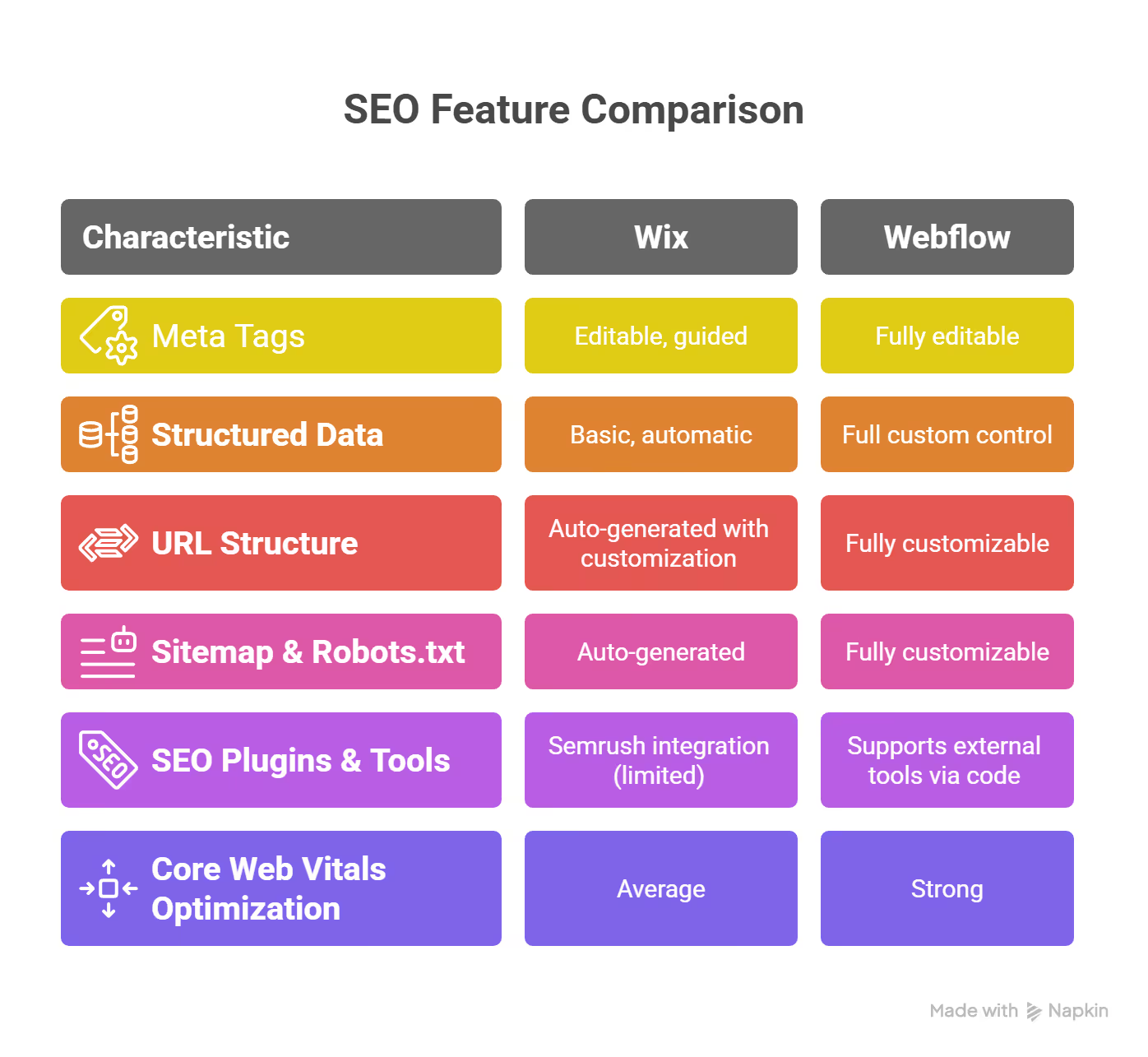
Wix has made major strides and is now a competitive SEO player—especially for beginners. But Webflow offers deeper, more precise control, making it the preferred platform for SEO professionals, large content sites, and businesses serious about ranking well.
Choosing the right website builder isn’t just about looks or ease of use—it's about conversion. If you're planning to sell products or services online, your platform needs robust e-commerce tools that are fast, flexible, and scalable. In the battle of Webflow vs Wix, both offer competitive online store solutions—but their approaches are fundamentally different.
Wix has built a reputation for making e-commerce accessible. With Wix Stores, you can set up a functional online shop in under an hour. The interface is intuitive, the product setup is streamlined, and the platform supports up to 50,000 products—far more than most small businesses will ever need.
Standout e-commerce features include:
What’s impressive is how tightly integrated Wix’s store functions are with its broader marketing tools. You can run email campaigns, create discount codes, and track inventory—all from a single dashboard. And with Wix Studio, you can push further into custom layouts and animations, adding polish to your storefront.
However, where Wix occasionally falls short is in design freedom. While you can customize product pages and checkout flows to a degree, you're still operating within the structure of your chosen template. If you need unique layouts or advanced shopping experiences, you’ll start to feel the constraints.
Webflow’s e-commerce platform is newer and still evolving—but it’s made for users who want total design and UX control. Every element of your online store is customizable: the product card layout, checkout form, cart animations, and even post-purchase emails.
Core e-commerce features in Webflow include:
That said, setting up e-commerce in Webflow takes more time. You'll need to understand the CMS structure and how to create dynamic templates. But the payoff is in creative control. Want to build a product grid that shifts based on screen width and customer preferences? You can. Need to create animated transitions between product views? It's possible—with no plugins or third-party themes required.
In terms of capacity, Webflow supports up to 15,000 products, which will suit most medium-sized operations. For anything larger, you might need to consider external integrations or headless commerce solutions.
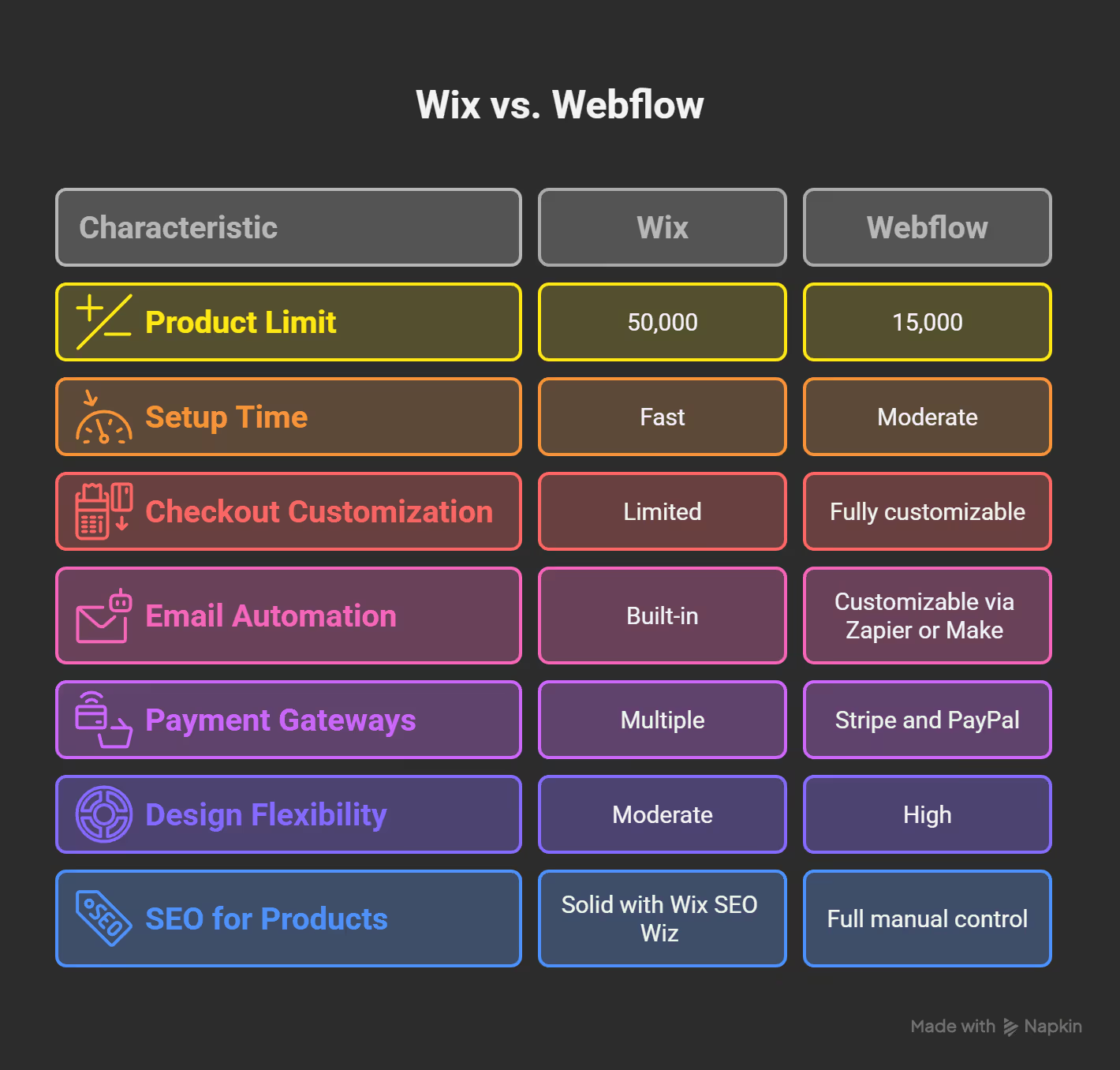
For creators and businesses that need a quick, scalable, and functional online store, Wix is a fantastic option—especially if you’re working within a tight timeline or limited technical expertise. But if your goal is a custom-branded shopping experience with rich animations, dynamic layouts, and complete design freedom, Webflow is the platform that delivers.
Building a website is just the beginning. To grow your brand, convert visitors, and drive repeat business, you need integrated marketing tools and customer relationship management (CRM) capabilities. Both Webflow and Wix recognize this, but they take markedly different approaches.
Wix doesn’t just help you build websites—it helps you run your business. With Ascend by Wix, users get access to a complete set of built-in marketing and CRM tools designed to eliminate the need for third-party services.
Wix Ascend includes:
One of the biggest advantages of Wix’s approach is integration. All these tools work seamlessly within the Wix dashboard. For example, a user can capture a lead through a form, nurture them with a drip campaign, and retarget them via Facebook—all without leaving the platform.
Even more compelling is the ease of use. Beginners can automate key marketing workflows, such as abandoned cart reminders or welcome emails, with just a few clicks. According to Zapier's 2025 comparison, many users find they no longer need separate tools like Mailchimp, Buffer, or HubSpot—Wix can do it all.
Webflow, in contrast, focuses heavily on design and development flexibility but leaves marketing integrations largely to external tools. It supports integrations with:
This modular approach works well for teams that already have a marketing stack in place and prefer using best-in-class tools. But it’s less convenient for beginners who might be looking for an all-in-one solution. If you want to run an email campaign or track social performance, you’ll need to embed code or connect through external platforms.
On the upside, Webflow’s open-ended nature means you can create highly custom lead capture forms, design your landing pages with microinteractions, and push data exactly where it needs to go. The platform’s CMS structure also allows for dynamic, SEO-friendly content marketing, ideal for blogging or content-heavy strategies.
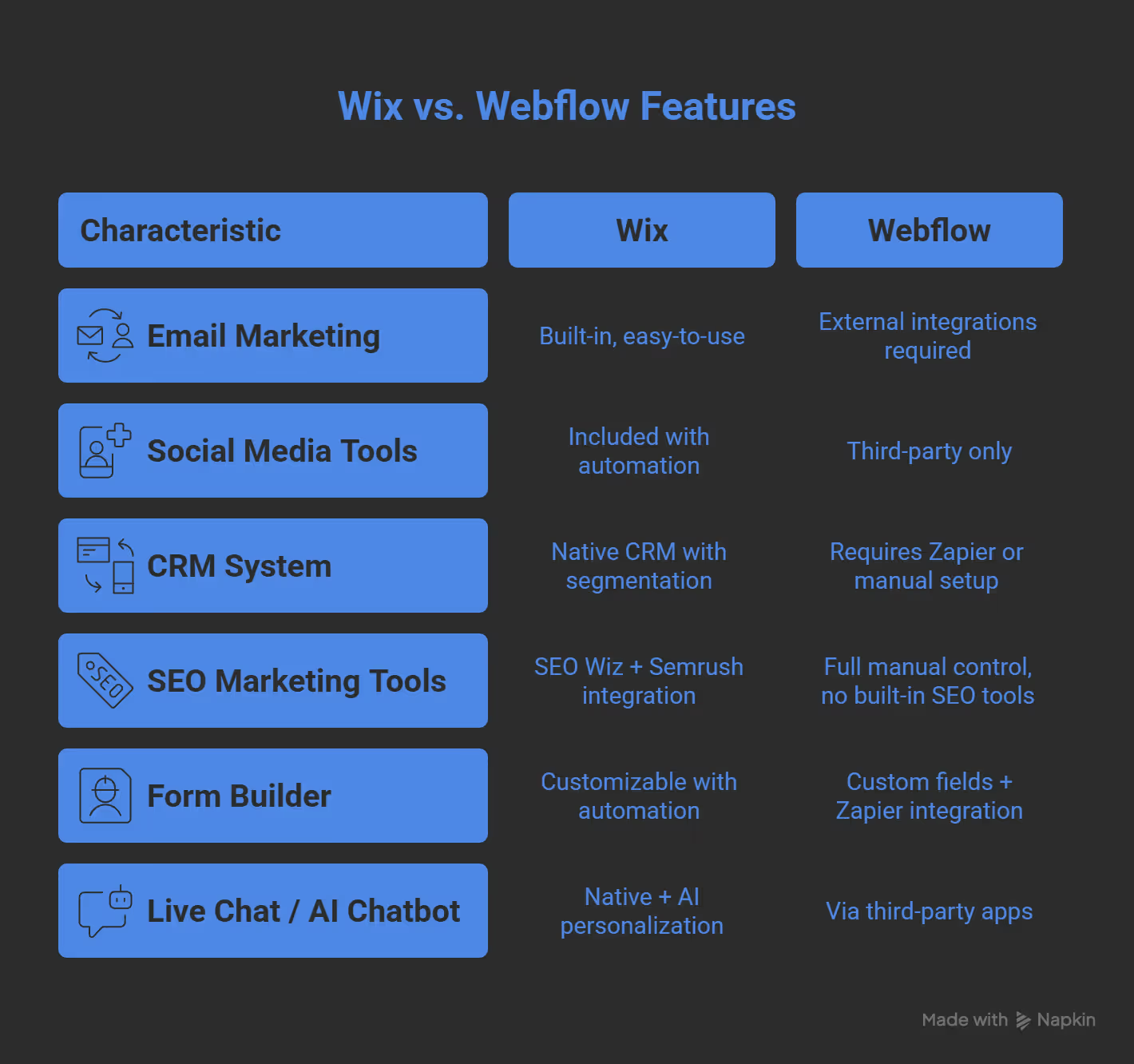
Wix clearly wins on convenience. Its built-in marketing suite and CRM tools make it ideal for small to mid-sized businesses that want to hit the ground running without complex integrations. But for teams that prioritize creative freedom and custom workflows, Webflow offers the flexibility to plug into almost any stack.
A powerful content strategy can turn casual visitors into loyal customers—and for many brands, that starts with a blog. Whether you’re a content creator, an agency, or an e-commerce brand using content to fuel SEO, your website builder needs to support efficient content creation and management.
So how does the Webflow vs Wix comparison stack up when it comes to blogging and CMS functionality?
Wix includes blogging functionality on nearly all its plans, and it’s extremely beginner-friendly. Users can quickly add a blog to their site, choose from a selection of layout templates, and start publishing immediately.
Notable blogging features in Wix:
Wix’s blog also connects seamlessly with its CRM and marketing tools. You can capture leads from blog CTAs, automate post-related emails, or retarget readers with paid ads—all inside the same platform.
However, Wix’s blog structure is relatively rigid. Advanced content layouts, custom templates, or nested categories are more difficult to implement. And while the platform handles multilingual content well through its native language manager, large-scale content sites may find it limiting in flexibility.
Webflow’s CMS is one of its most powerful (and underrated) features. Unlike traditional blogging tools, Webflow lets you create custom content types—called “Collections”—which go beyond standard posts. You can define fields, layouts, and dynamic content structures for any type of page: blogs, case studies, team directories, product libraries, and more.
Key advantages of Webflow CMS:
Need a blog homepage that displays posts by tag, sorted by popularity, and styled in a grid with animations? Webflow handles it with ease. And because everything is built using the visual designer, you can tailor your blog’s look to fit your brand exactly—without relying on a template.
Where Webflow truly shines is scalability. With support for thousands of CMS items (20,000+ on Business plans), the platform is ideal for editorial teams, content marketers, and SEO agencies that publish regularly and require flexible structures.
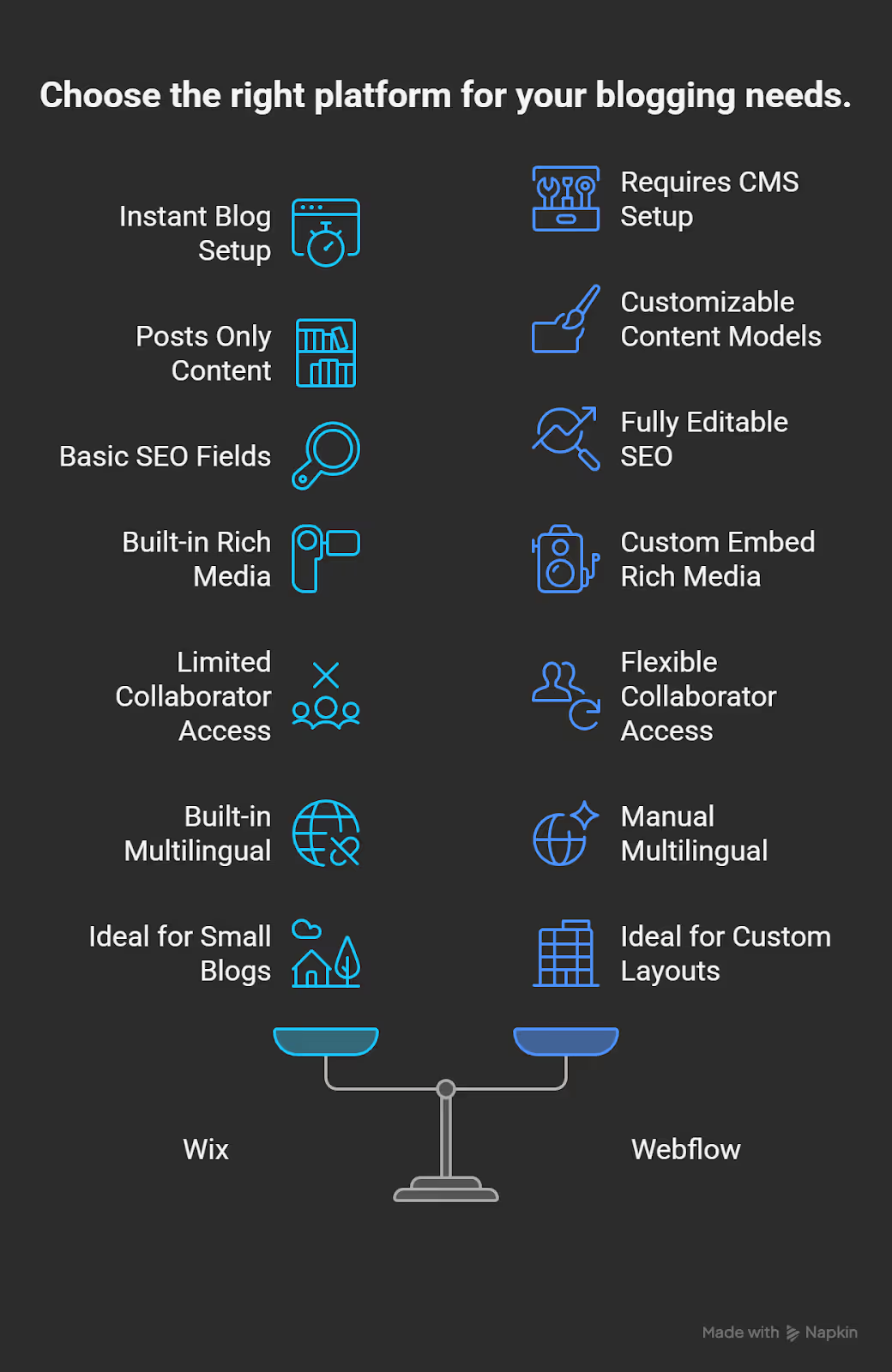
If you're looking for a blog that's easy to launch and ties into your email and social strategy, Wix delivers a strong, accessible solution. But if you're planning a content-rich site with advanced layout requirements, editorial workflows, and custom structures, Webflow offers superior flexibility and power.
In an era where efficiency and personalization are paramount, artificial intelligence has become a must-have rather than a novelty. From generating website content to automating customer interactions, AI tools can drastically reduce manual effort while improving user experience. In the context of Webflow vs Wix, both platforms are making strides—though with different philosophies and feature sets.
Wix is ahead of the curve when it comes to built-in AI features. Its Artificial Design Intelligence (Wix ADI) has been a cornerstone of the platform’s onboarding experience for years. With just a few answers to simple prompts, Wix ADI can build a full-featured website tailored to your business needs—complete with content, images, and even pre-configured apps.
But the innovation doesn’t stop there.
In 2025, Wix introduced several new AI tools that expand its automation capabilities:
These tools are seamlessly integrated into Wix’s dashboard, making them incredibly easy to use. The AI chatbot, for instance, can answer questions, collect leads, and route user queries to your CRM—all with customizable personality settings. According to Wix’s own 2024 product release summary, adoption of its AI-powered email builder increased campaign open rates by up to 25%.
Webflow has recently started integrating AI into its platform—but it’s currently in early stages compared to Wix. Its AI capabilities are focused primarily on design assistance and copy generation.
Here’s what’s available as of 2025:
While helpful, these features are less about full automation and more about speeding up workflow within the visual editor. Webflow doesn’t yet offer native tools for AI-driven SEO, customer support, or marketing automation—though you can achieve similar functionality through third-party tools like Jasper, Writesonic, or Zapier.
What Webflow lacks in native AI, it makes up for in integration flexibility. You can embed OpenAI-powered chatbots, train custom AI models via APIs, or connect advanced marketing flows using automation platforms like Make or Zapier. But it does require more technical know-how to set up.

For businesses that want hands-off automation, intelligent content creation, and a plug-and-play marketing stack, Wix offers unmatched convenience. But if your goal is to build custom AI-enhanced workflows or embed third-party logic into a sophisticated site, Webflow provides the structure and openness needed for that level of control.
In today’s web development landscape, websites aren’t just built by individuals—they’re built by teams. Whether you’re part of an agency, a startup, or an enterprise content team, your platform needs to support real-time collaboration, version control, and role-based permissions. Here's how Webflow vs Wix compares on this critical dimension.
Historically, Wix was designed for solo creators. But with the launch of Wix Studio, the platform has expanded its capabilities to support design and marketing teams more effectively.
Wix Studio offers:
These features make it much easier for agencies to maintain workflows and branding consistency. The Studio interface also allows multiple users to design simultaneously, a feature previously unavailable in Wix’s standard builder.
What’s still missing, however, is true version control or page branching—a feature developers often rely on to test design iterations without disrupting live pages.
Webflow has long been favored by professional teams because it understands the granular needs of collaborative web projects. The platform supports a sophisticated structure for role separation and project management.
Key features in Webflow:
This setup is particularly effective for agencies and in-house design teams. For example, a marketing manager can publish blog posts and update product details while the design team iterates on a homepage revamp in a separate staging environment. There’s no risk of overwriting each other’s work.
And if you’re managing multiple client sites, Webflow’s Workspace plans allow for shared resources, streamlined billing, and better control over user access.
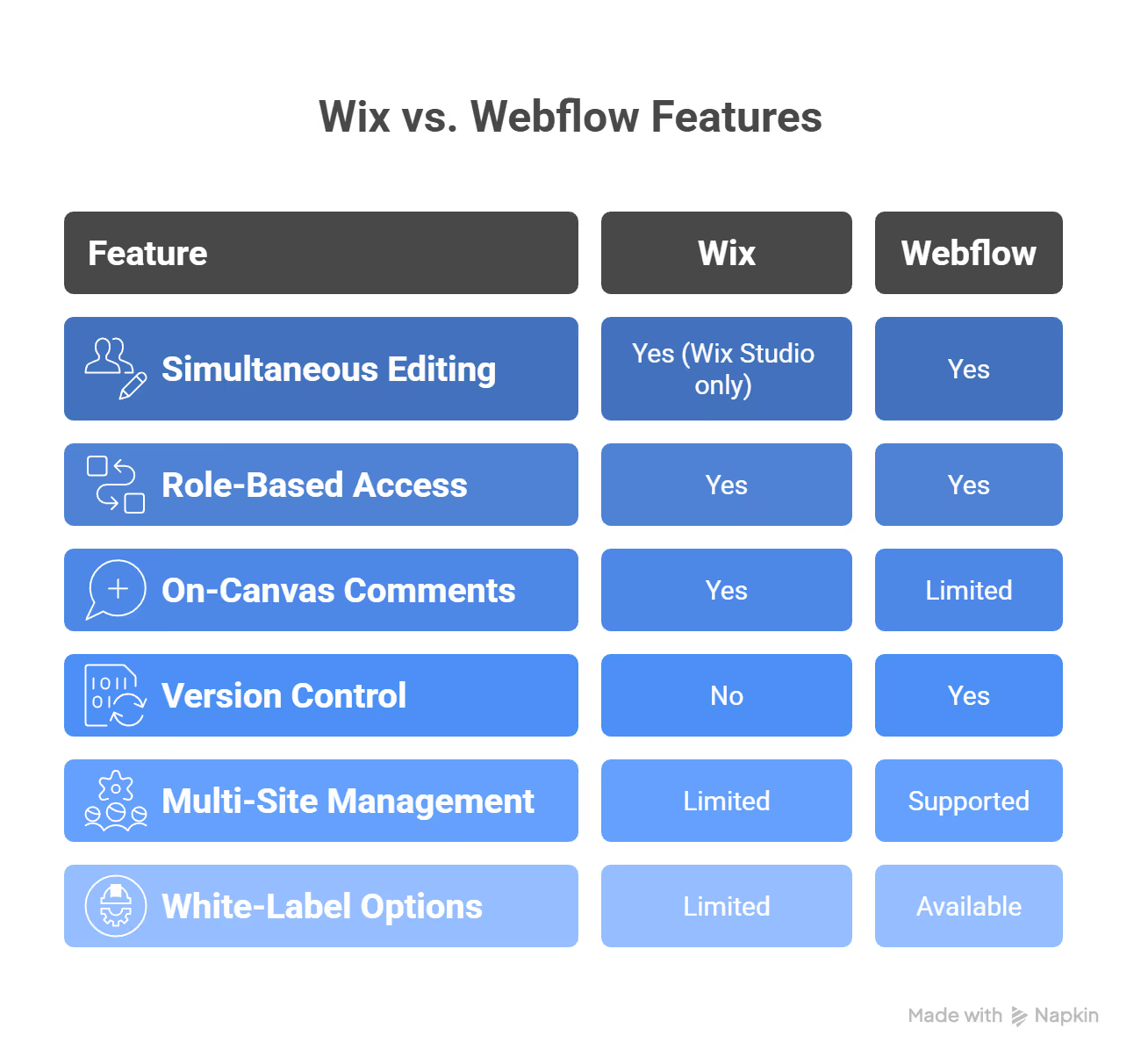
If your workflow includes feedback cycles, content contributors, and brand consistency, Wix Studio delivers a strong foundation for growing teams. But for professional teams handling complex, multi-stage projects, Webflow remains the superior choice due to its mode separation, page versioning, and deep team structure.
A website builder's true power often lies in how well it integrates with other tools. Whether you’re collecting leads, analyzing traffic, automating workflows, or syncing with CRMs, your platform needs to plug into the larger ecosystem of business software. This is where Webflow vs Wix reveals some distinct differences in philosophy and capability.
Wix is all about convenience—and that extends to its app integrations. With over 800 apps available in the Wix App Market, users can add features like live chat, appointment booking, social media feeds, reviews, and email marketing with just a few clicks.
Key integration highlights:
What sets Wix apart is how accessible these integrations are. Everything is available within the dashboard, often requiring no technical knowledge to install or manage. It’s an ecosystem that prioritizes ease of use over customization depth.
However, the downside is that you’re largely limited to what the app market offers. While you can embed HTML and JavaScript via the Velo development environment, doing so takes you outside of Wix’s otherwise simple workflow.
Webflow doesn’t offer an internal app market like Wix, but it makes up for it with developer-grade integration flexibility. Whether you're embedding a chatbot, syncing a database, or powering your blog through a headless CMS—Webflow makes it possible.
Core extendibility features include:
For agencies and startups needing flexibility to build workflows or connect to proprietary tools, Webflow provides the infrastructure. And because its code output is clean and semantic, developers can continue building on top of Webflow sites without the friction common in other platforms.
That said, if you’re not comfortable with embedding scripts or working with APIs, Webflow’s flexibility can feel more like a burden than a benefit.
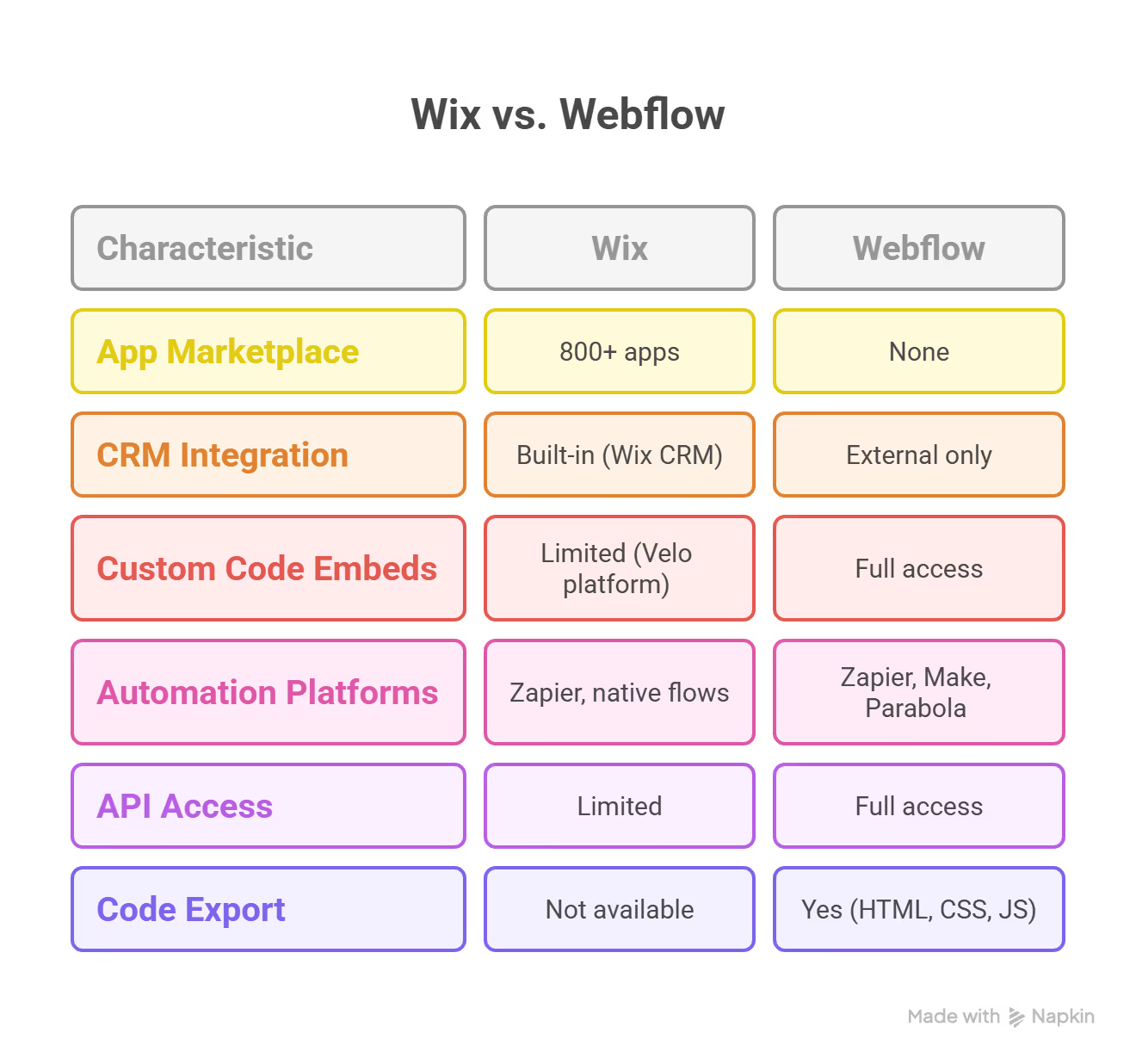
For users who want pre-built, easy-to-use integrations, Wix provides an expansive and beginner-friendly ecosystem. But if your project demands custom workflows, third-party APIs, or full code control, Webflow is the clear leader.
When choosing a website platform, what happens behind the scenes is just as important as what happens on screen. Reliable hosting ensures your site is fast, secure, and always available—regardless of where your audience is located. In the debate of Webflow vs Wix, both offer integrated hosting, but with distinct approaches and advantages.
Wix is a fully hosted solution. This means every Wix plan—free or paid—includes hosting with no configuration required. You never need to think about servers, bandwidth limits, or CDNs. It’s all handled automatically.
Wix hosting highlights:
Because Wix is an all-in-one platform, the hosting is deeply integrated with its editor, e-commerce tools, and analytics. You don’t need to juggle multiple services or connect external infrastructure—ideal for users who want a set-it-and-forget-it experience.
However, you don’t get much control over hosting specifics like server location, caching behavior, or CDN configuration. And you’re locked into Wix’s infrastructure—you can’t migrate your site to another host.
Webflow also provides built-in hosting, but it’s built on enterprise-grade infrastructure. Powered by Amazon Web Services (AWS) and Fastly CDN, Webflow’s hosting is designed for performance, scalability, and flexibility.
Key Webflow hosting features:
Where Webflow shines is in performance and flexibility. Your site benefits from semantic HTML and clean code, making it inherently faster. You also have more control over site settings, including advanced SEO controls, redirect rules, and meta tag management—critical for developers and marketers.
Plus, Webflow offers the rare ability to export your code and host your site elsewhere. This gives agencies and enterprises a valuable fallback plan if they ever need to migrate or integrate with other systems.
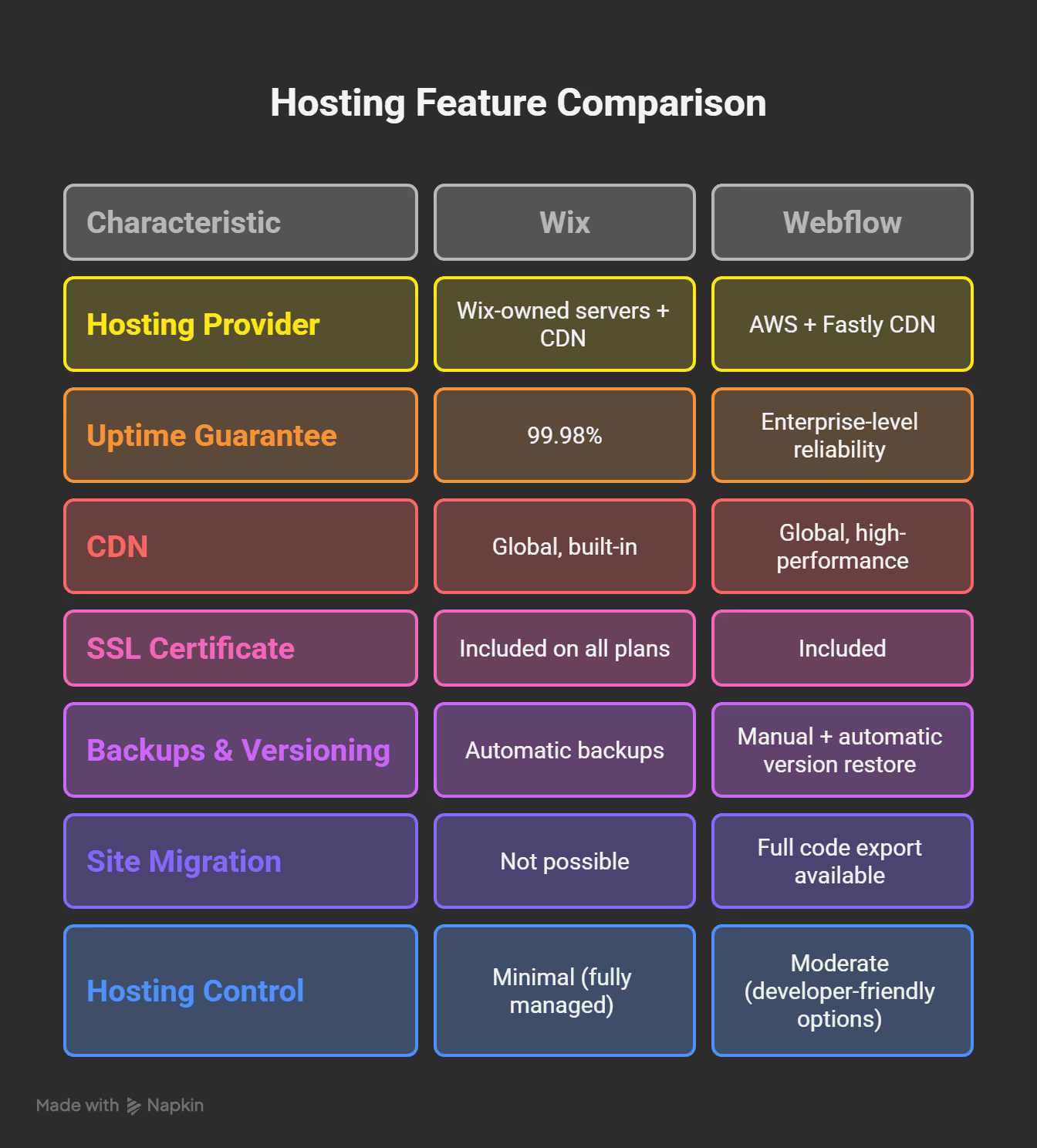
For users who want fully managed, worry-free hosting, Wix is an excellent choice. It’s simple, seamless, and reliable. But if you value performance optimization, migration flexibility, and more granular control, Webflow’s infrastructure is a clear winner.
Whether you're starting small or already planning for long-term growth, your website platform should be able to scale with your business. That means handling more content, more traffic, and more complexity—without forcing a platform switch. In the context of Webflow vs Wix, both platforms offer scalable solutions, but they do so in very different ways.
Wix is purpose-built for small to mid-sized businesses, and it excels at helping users grow without needing technical skills. With features like multilingual support, advanced booking tools, built-in CRM, and a powerful e-commerce engine, it’s well-equipped to scale many types of websites—from online stores to coaching businesses to media outlets.
Scalable Wix features include:
The biggest strength of Wix’s scalability is that you don’t need to bring in developers. You can add new features using apps from the Wix App Market, upgrade your plan as needed, and manage everything through a unified interface.
However, you're locked into Wix’s proprietary ecosystem. That means if your business reaches a level where it requires deeper customization, external hosting, or integration with more complex tools, Wix becomes harder to scale beyond its own limits.
Webflow is designed with flexibility in mind. It offers a blank canvas for design, development, and scaling—ideal for businesses that expect to grow or already operate at a higher tier of complexity.
Webflow supports:
What sets Webflow apart is its ability to adapt. Whether you're a SaaS startup creating hundreds of landing pages or an agency managing dozens of client sites, you can build exactly what you need—without being limited by template restrictions or platform constraints.
It’s not just about growth in traffic or product listings. Webflow’s scalability also supports creative and structural freedom, which is essential for brands with evolving needs or custom user experiences.
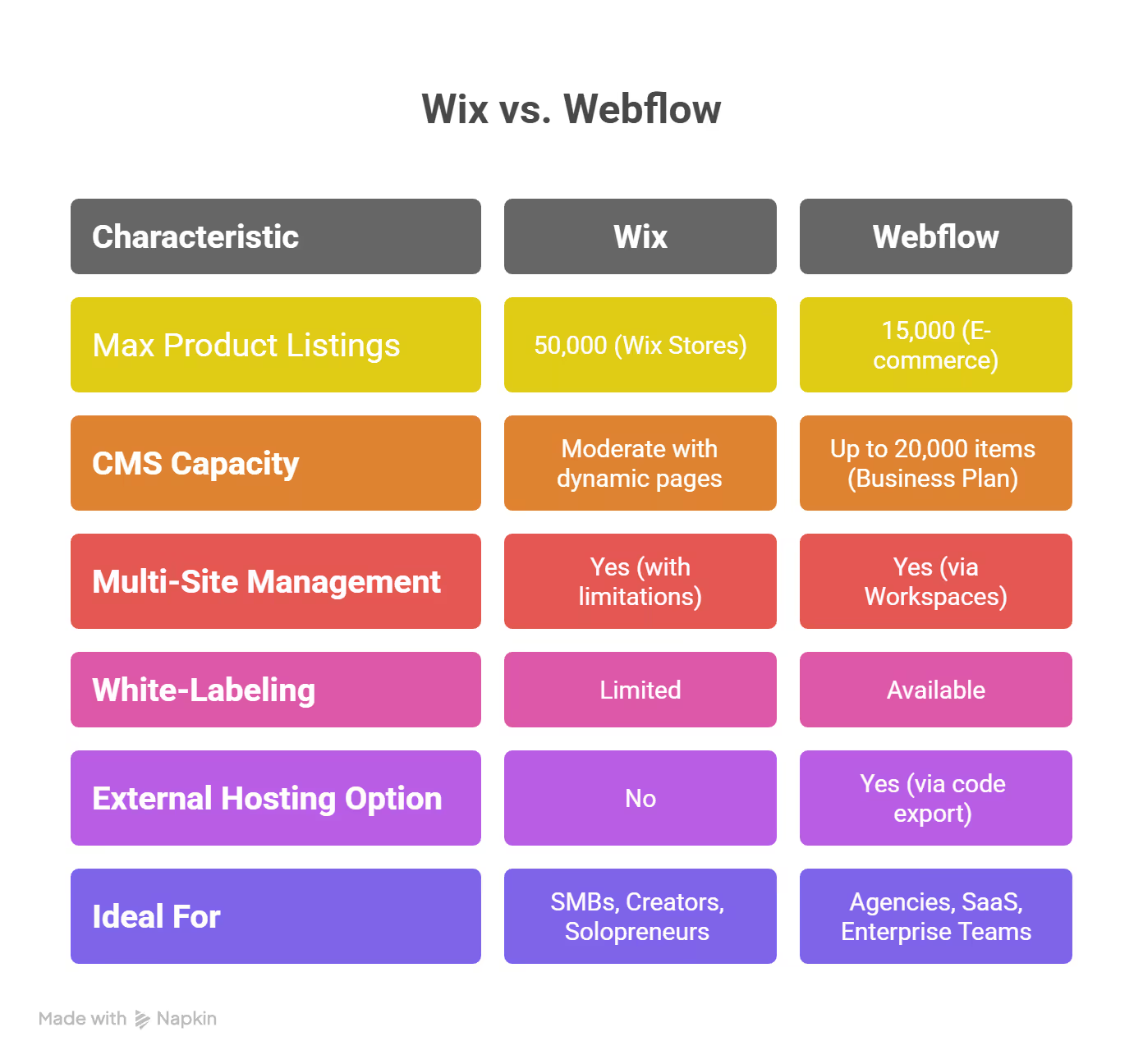
If you want turnkey scalability with low maintenance, Wix offers an attractive solution for businesses looking to grow quickly without technical overhead. But if your business requires custom content types, high-performance layouts, or long-term flexibility, Webflow is the platform better suited for serious scale.
Choosing the right platform often comes down to one critical factor: cost. Beyond the monthly fee, it’s important to consider what features you’re actually getting—and whether your investment scales with your needs. In the showdown of Webflow vs Wix, the pricing structures reflect each platform's approach: simplicity vs. granularity.
Wix offers four core pricing plans under its website builder lineup and three additional tiers for business and e-commerce. Starting at just $17/month, Wix includes basic blogging capabilities, site analytics, two collaborators, and limited storage. The Core Plan ($29/month) enables e-commerce functionality and is ideal for small online shops, offering up to 50,000 products, which is more than enough for most users.
Here’s a snapshot of Wix’s business-focused plans:
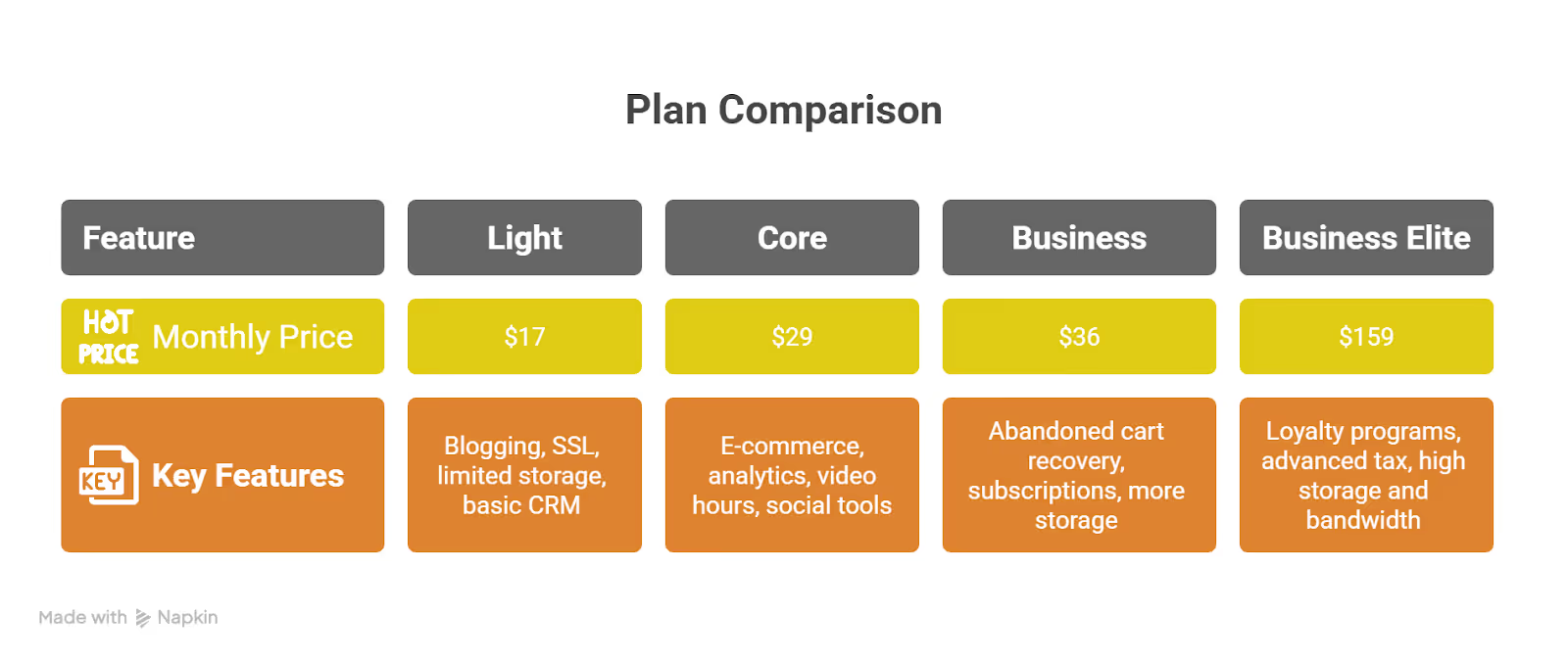
Wix also includes a free plan, which is great for testing—but it displays Wix ads and doesn’t allow a custom domain.
Webflow separates its pricing into Site Plans and Workspace Plans. Site Plans are tied to individual websites and determine features like CMS access, custom domains, and traffic limits. Workspace Plans, meanwhile, support multi-site development and team collaboration.
Here’s a breakdown of popular Webflow Site Plans:
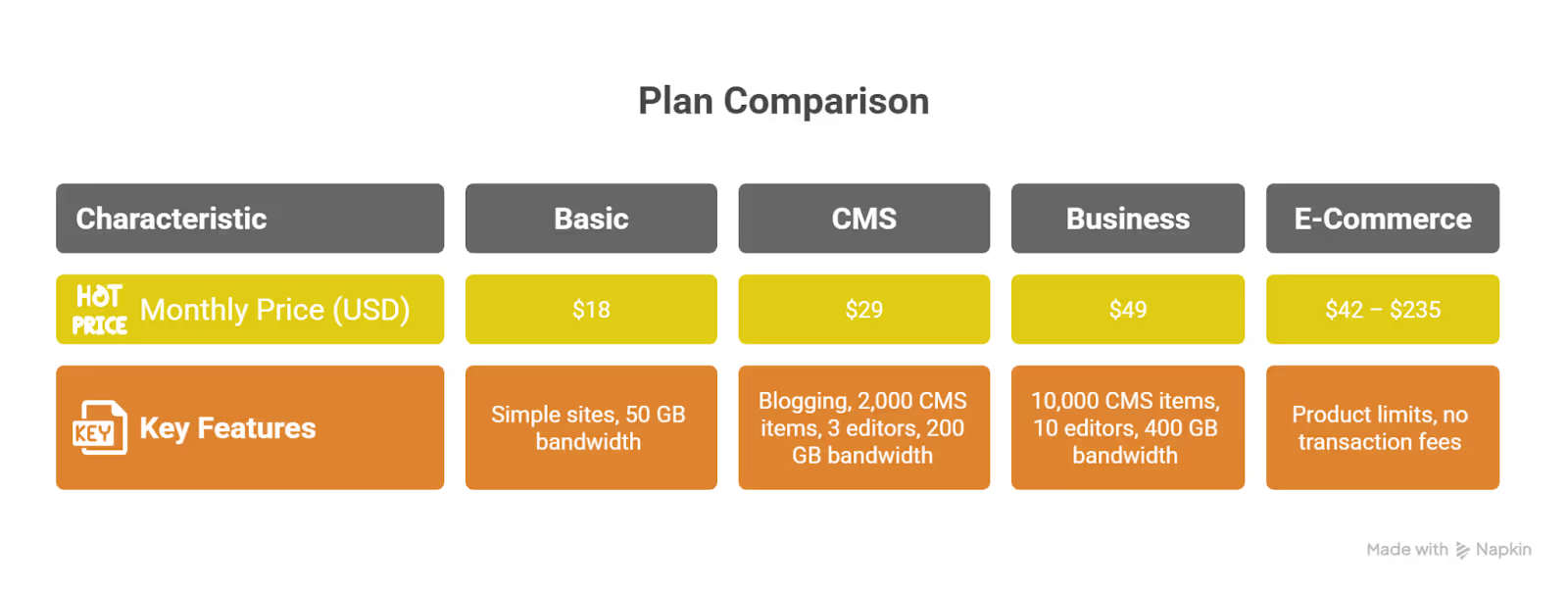
Webflow doesn’t offer a free plan for live sites, but you can build and preview your project without publishing. However, the free plan is limited to 2 pages and uses a branded subdomain.
It’s also worth noting that to unlock features like site search, page branching, or multiple users, you’ll need to upgrade to Workspace plans starting at $28/month.
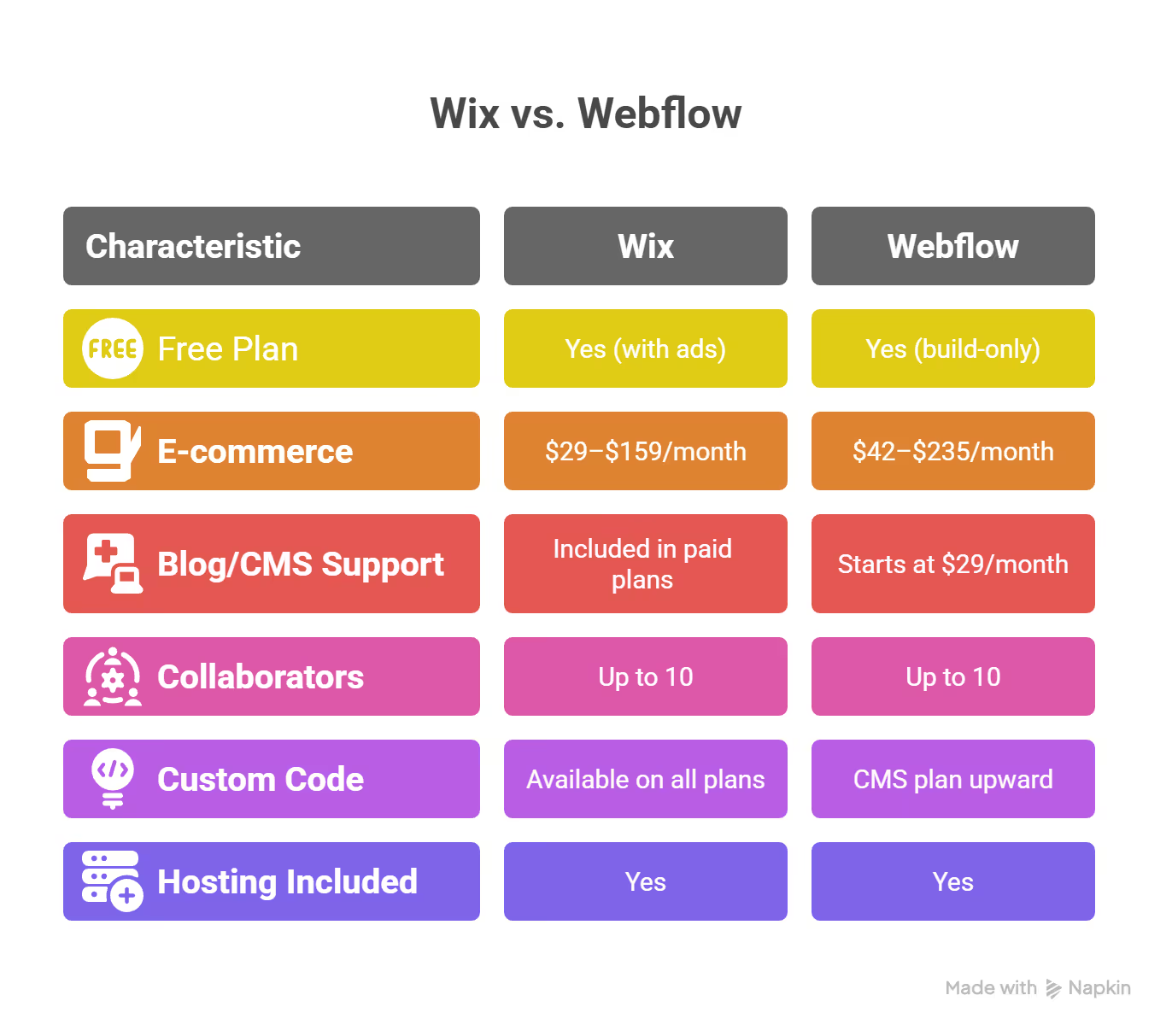
Wix offers more value at a lower entry cost, making it ideal for creators, small businesses, and e-commerce sites that need rich features without breaking the bank. Webflow, on the other hand, is a premium choice, designed for those who prioritize custom design, scalability, and advanced workflows. For growing teams or design-centric agencies, the higher pricing is often justified by the additional control and performance.
Even the most intuitive platform comes with a learning curve—especially when you're building a site that’s meant to scale, sell, or stand out. This is where documentation, tutorials, and community engagement make all the difference. When comparing Webflow vs Wix, the contrast in their educational ecosystems is just as important as their feature sets.
Wix has spent years refining its user experience to support beginners and non-technical users. Its help resources are deeply integrated into the platform and available in multiple formats.
Wix support offerings include:
For most users, Wix support is fast and highly accessible. If you're stuck on how to connect a domain, build a custom form, or launch a store, the help center likely has a ready-made tutorial. According to Website Planet’s 2025 review, Wix’s customer support responded faster and with more detail than Webflow during head-to-head testing.
Wix also invests in educational content across platforms—YouTube, webinars, and blog posts—making it easy for creators to learn and grow at their own pace.
Webflow’s learning resources cater to designers, developers, and marketers who want to dig deep into the platform. It assumes a higher baseline level of technical curiosity—and delivers accordingly.
Core support resources include:
While Webflow doesn’t currently offer live chat or phone support for standard users, the depth of its documentation and video content is unmatched in the no-code space. Whether you're trying to design a parallax effect or export clean HTML, you’ll find an expert-level tutorial at Webflow University.
Moreover, Webflow’s community of designers is strong, vocal, and committed to pushing boundaries. It’s a platform built for professionals—so expect high-quality dialogue in the forums and deep dives in the content.
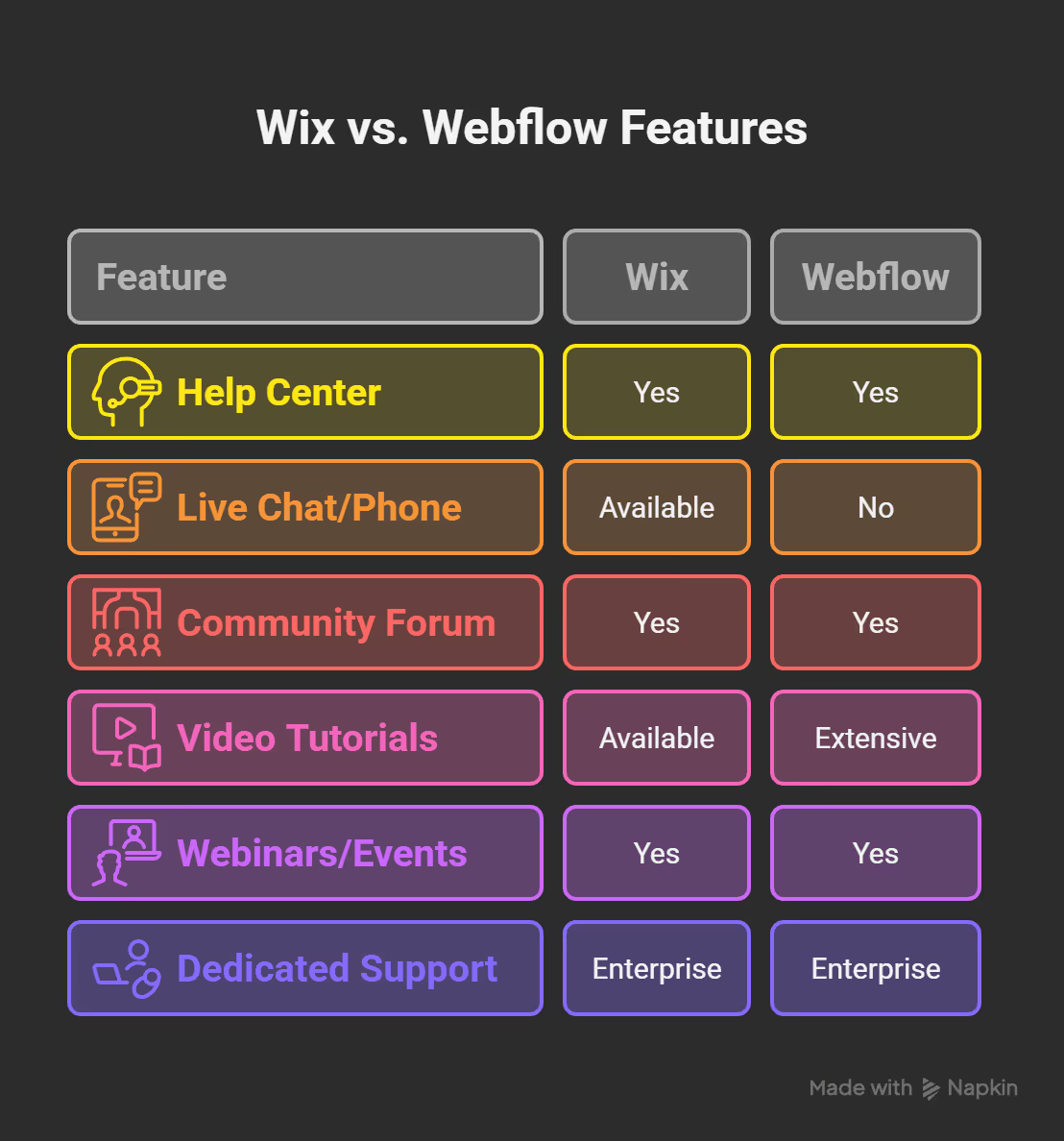
For beginners and business owners who need quick answers and hand-holding, Wix offers better accessibility and a faster learning curve. But for those who are serious about mastering design systems, layout logic, and no-code development, Webflow’s educational platform is an industry benchmark.
Webflow is not your average website builder. It’s a platform crafted for precision, customizability, and professional-grade design. If you're considering Webflow, it's important to understand who benefits most from its capabilities—and who might find it overkill.
Webflow is a favorite among creative professionals because it bridges the gap between visual design and front-end development. Designers can translate their ideas directly into functional websites without compromising quality or relying on developers.
Key benefits for agencies and freelancers:
If you're building portfolios, small business websites, or landing pages that require a tailored look and feel, Webflow enables you to offer higher-value services and differentiate your work.
Startups often need fast iteration cycles and conversion-optimized designs. Webflow gives marketers and product teams control over their web presence without involving engineering every time a change is needed.
Use cases include:
Webflow’s CMS plan is ideal for publishing thought leadership content, while its Business plan supports dynamic scaling and advanced analytics tracking.
Larger organizations and enterprise teams benefit from Webflow’s structured workflows. With Edit, Design, and Build modes, roles are clearly defined—ensuring that content teams can make updates without breaking the layout.
For collaborative teams, Webflow offers:
If your organization juggles multiple roles—designers, marketers, developers—Webflow keeps everyone in sync without slowing down the creative process.
Because Webflow outputs clean HTML and is built on a fast CDN, it’s ideal for users who prioritize technical SEO and Core Web Vitals. You get complete control over:
In SEO-driven industries—such as SaaS, digital publishing, or local services—this level of control can directly impact traffic and conversions.
In short, Webflow is best for those who want to build unique, high-performing, and scalable websites with full control over every detail.
Wix is built around the idea of making website creation accessible to everyone—no coding, no complexity, no headaches. Its strength lies in its simplicity, rapid deployment, and all-in-one ecosystem. But it’s more than just a beginner’s tool. In fact, in 2025, Wix is powerful enough to support serious businesses, agencies, and content creators alike.
If you're a restaurant owner, yoga instructor, life coach, or boutique store owner, Wix makes it easy to launch your online presence in under an hour. You don’t need a designer, developer, or marketer to get started.
Key benefits for small businesses:
With everything managed under one roof, Wix helps entrepreneurs focus on their business rather than technology.
Wix is ideal for creators who want to blog, host videos, or manage digital portfolios without fiddling with backend systems. You get:
For creators who value convenience and want a quick way to go live and share their work, Wix hits the sweet spot.
If your primary goal is to sell online quickly, Wix gives you everything you need—no coding, no plugins. You can:
For businesses that don’t need heavily customized storefronts or headless setups, Wix’s e-commerce is both powerful and easy to use.
Wix Studio has made Wix a viable option for design teams and freelancers who need to manage multiple client projects.
Agency features include:
It’s perfect for agencies that want to balance client flexibility with project control, and it allows junior designers or marketers to collaborate without risk of breaking the site structure.
In summary, Wix is ideal for those who want a fast, affordable, and all-in-one platform to build, manage, and grow a professional website—without touching a single line of code.
After deep-diving into design flexibility, performance, SEO, e-commerce, scalability, support, and pricing, it’s clear that Webflow and Wix cater to very different needs. One isn’t strictly better than the other—they’re better for different types of users.
Here’s a breakdown to help guide your final decision.
Webflow excels when the visual matters just as much as functionality—and when your team can leverage the platform’s rich, developer-grade flexibility.
Wix wins for users who need speed and convenience without sacrificing professional-grade tools. With Wix Studio, even more advanced use cases are now viable—making Wix a solid option for agencies and growing brands.
Decision Matrix: What’s Most Important to You?
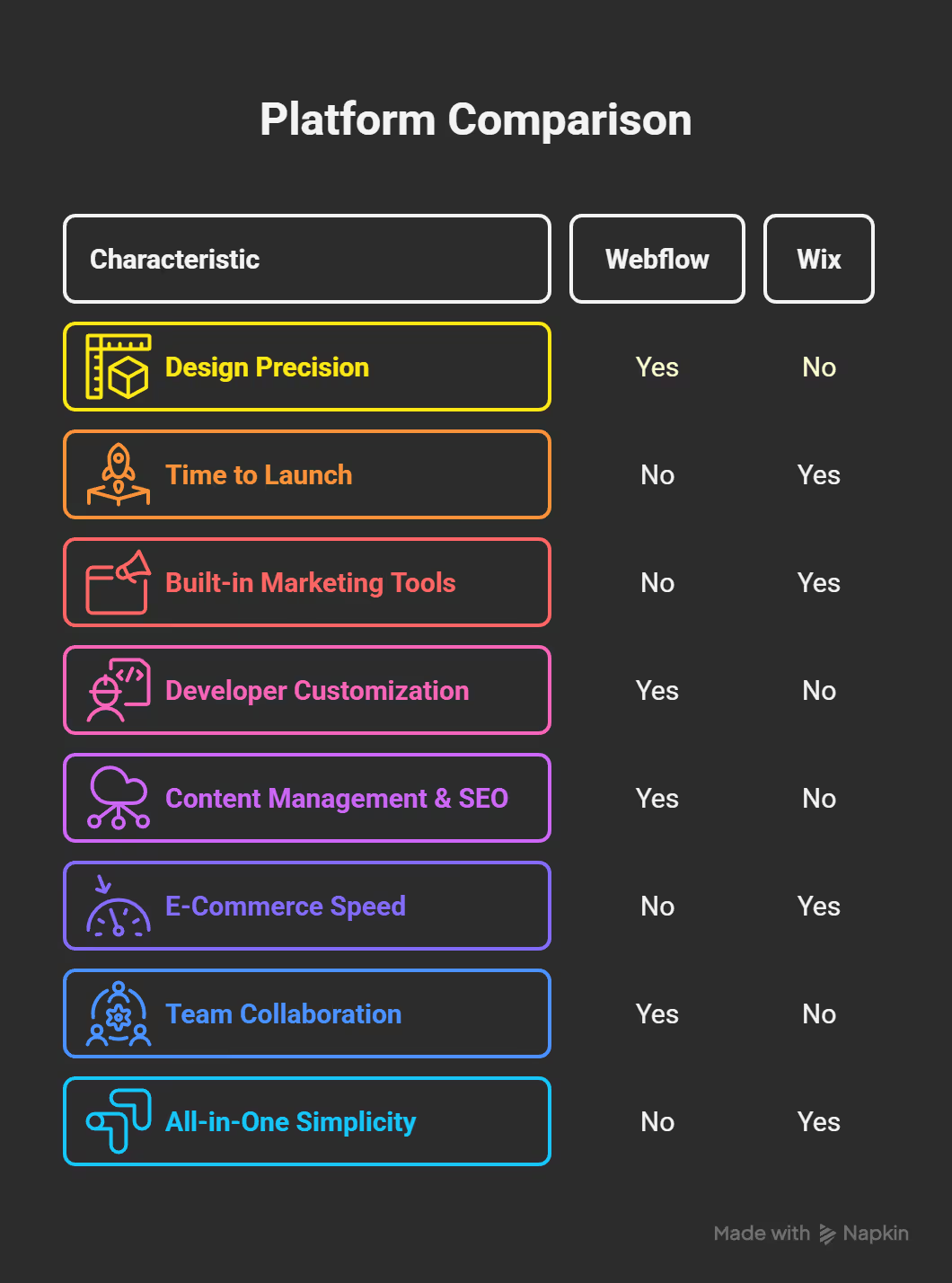
Ultimately, your decision should align with your current needs and future ambitions. If you’re planning to scale fast and design freely, Webflow is worth the learning curve. If you’re building now and need fast ROI, Wix is built for you.
Yes, Webflow has a steeper learning curve than Wix. It offers granular control over design and layout, similar to a development environment, which makes it ideal for designers and professionals. Wix, on the other hand, is much more user-friendly for beginners and business owners who want to get online fast.
While technically possible, switching platforms isn't seamless. You can’t export Wix or Webflow websites directly. Migrating content often requires manual effort or third-party tools. If long-term flexibility is important, Webflow’s ability to export clean code offers more future-proofing.
Webflow offers more advanced SEO control with cleaner code, editable meta tags, and flexible URL structures. Wix has improved significantly and now includes features like SEO Wiz and Semrush integration. However, SEO professionals generally prefer Webflow for its technical precision.
Yes. Wix supports up to 50,000 products and includes built-in tools for payments, tax, shipping, and automation. It’s ideal for small to medium e-commerce businesses. However, if you require unique product layouts or third-party logistics integration, Webflow might offer more control.
Yes. Both Wix and Webflow support blogging. Wix provides a built-in blog editor that's easy to use and great for quick publishing. Webflow offers a powerful CMS for complex content strategies and custom blog layouts, ideal for content-heavy brands and agencies.
Webflow is generally more future-proof if you're planning to scale your website's functionality, traffic, and team. It supports more customization, flexible integrations, and high-performance hosting. That said, Wix Studio has narrowed the gap with more robust features for agencies and businesses.
The final choice between Webflow vs Wix depends on your vision. If you're seeking a polished, scalable, and uniquely designed website with SEO precision and full customization, Webflow is the long-term solution. For entrepreneurs, creators, and small businesses looking for speed, affordability, and all-in-one ease, Wix is incredibly hard to beat.
Both platforms are continually evolving, so your decision should reflect not just where you are—but where you want your website to go.
If you’re looking for expert guidance or done-for-you website design, check out the Ballistic Design Studio. Whether you're leaning toward Wix or Webflow, the team at Ballistic can help you design, launch, and scale with confidence.
A website builder's true power often lies in how well it integrates with other tools. Whether you’re collecting leads, analyzing traffic, automating workflows, or syncing with CRMs, your platform needs to plug into the larger ecosystem of business software. This is where Webflow vs Wix reveals some distinct differences in philosophy and capability.
Wix is all about convenience—and that extends to its app integrations. With over 800 apps available in the Wix App Market, users can add features like live chat, appointment booking, social media feeds, reviews, and email marketing with just a few clicks.
Key integration highlights:
What sets Wix apart is how accessible these integrations are. Everything is available within the dashboard, often requiring no technical knowledge to install or manage. It’s an ecosystem that prioritizes ease of use over customization depth.
However, the downside is that you’re largely limited to what the app market offers. While you can embed HTML and JavaScript via the Velo development environment, doing so takes you outside of Wix’s otherwise simple workflow.
Webflow doesn’t offer an internal app market like Wix, but it makes up for it with developer-grade integration flexibility. Whether you're embedding a chatbot, syncing a database, or powering your blog through a headless CMS—Webflow makes it possible.
Core extendibility features include:
For agencies and startups needing flexibility to build workflows or connect to proprietary tools, Webflow provides the infrastructure. And because its code output is clean and semantic, developers can continue building on top of Webflow sites without the friction common in other platforms.
That said, if you’re not comfortable with embedding scripts or working with APIs, Webflow’s flexibility can feel more like a burden than a benefit.

For users who want pre-built, easy-to-use integrations, Wix provides an expansive and beginner-friendly ecosystem. But if your project demands custom workflows, third-party APIs, or full code control, Webflow is the clear leader.
When choosing a website platform, what happens behind the scenes is just as important as what happens on screen. Reliable hosting ensures your site is fast, secure, and always available—regardless of where your audience is located. In the debate of Webflow vs Wix, both offer integrated hosting, but with distinct approaches and advantages.
Wix is a fully hosted solution. This means every Wix plan—free or paid—includes hosting with no configuration required. You never need to think about servers, bandwidth limits, or CDNs. It’s all handled automatically.
Wix hosting highlights:
Because Wix is an all-in-one platform, the hosting is deeply integrated with its editor, e-commerce tools, and analytics. You don’t need to juggle multiple services or connect external infrastructure—ideal for users who want a set-it-and-forget-it experience.
However, you don’t get much control over hosting specifics like server location, caching behavior, or CDN configuration. And you’re locked into Wix’s infrastructure—you can’t migrate your site to another host.
Webflow also provides built-in hosting, but it’s built on enterprise-grade infrastructure. Powered by Amazon Web Services (AWS) and Fastly CDN, Webflow’s hosting is designed for performance, scalability, and flexibility.
Key Webflow hosting features:
Where Webflow shines is in performance and flexibility. Your site benefits from semantic HTML and clean code, making it inherently faster. You also have more control over site settings, including advanced SEO controls, redirect rules, and meta tag management—critical for developers and marketers.
Plus, Webflow offers the rare ability to export your code and host your site elsewhere. This gives agencies and enterprises a valuable fallback plan if they ever need to migrate or integrate with other systems.

For users who want fully managed, worry-free hosting, Wix is an excellent choice. It’s simple, seamless, and reliable. But if you value performance optimization, migration flexibility, and more granular control, Webflow’s infrastructure is a clear winner.
Whether you're starting small or already planning for long-term growth, your website platform should be able to scale with your business. That means handling more content, more traffic, and more complexity—without forcing a platform switch. In the context of Webflow vs Wix, both platforms offer scalable solutions, but they do so in very different ways.
Wix is purpose-built for small to mid-sized businesses, and it excels at helping users grow without needing technical skills. With features like multilingual support, advanced booking tools, built-in CRM, and a powerful e-commerce engine, it’s well-equipped to scale many types of websites—from online stores to coaching businesses to media outlets.
Scalable Wix features include:
The biggest strength of Wix’s scalability is that you don’t need to bring in developers. You can add new features using apps from the Wix App Market, upgrade your plan as needed, and manage everything through a unified interface.
However, you're locked into Wix’s proprietary ecosystem. That means if your business reaches a level where it requires deeper customization, external hosting, or integration with more complex tools, Wix becomes harder to scale beyond its own limits.
Webflow is designed with flexibility in mind. It offers a blank canvas for design, development, and scaling—ideal for businesses that expect to grow or already operate at a higher tier of complexity.
Webflow supports:
What sets Webflow apart is its ability to adapt. Whether you're a SaaS startup creating hundreds of landing pages or an agency managing dozens of client sites, you can build exactly what you need—without being limited by template restrictions or platform constraints.
It’s not just about growth in traffic or product listings. Webflow’s scalability also supports creative and structural freedom, which is essential for brands with evolving needs or custom user experiences.

If you want turnkey scalability with low maintenance, Wix offers an attractive solution for businesses looking to grow quickly without technical overhead. But if your business requires custom content types, high-performance layouts, or long-term flexibility, Webflow is the platform better suited for serious scale.

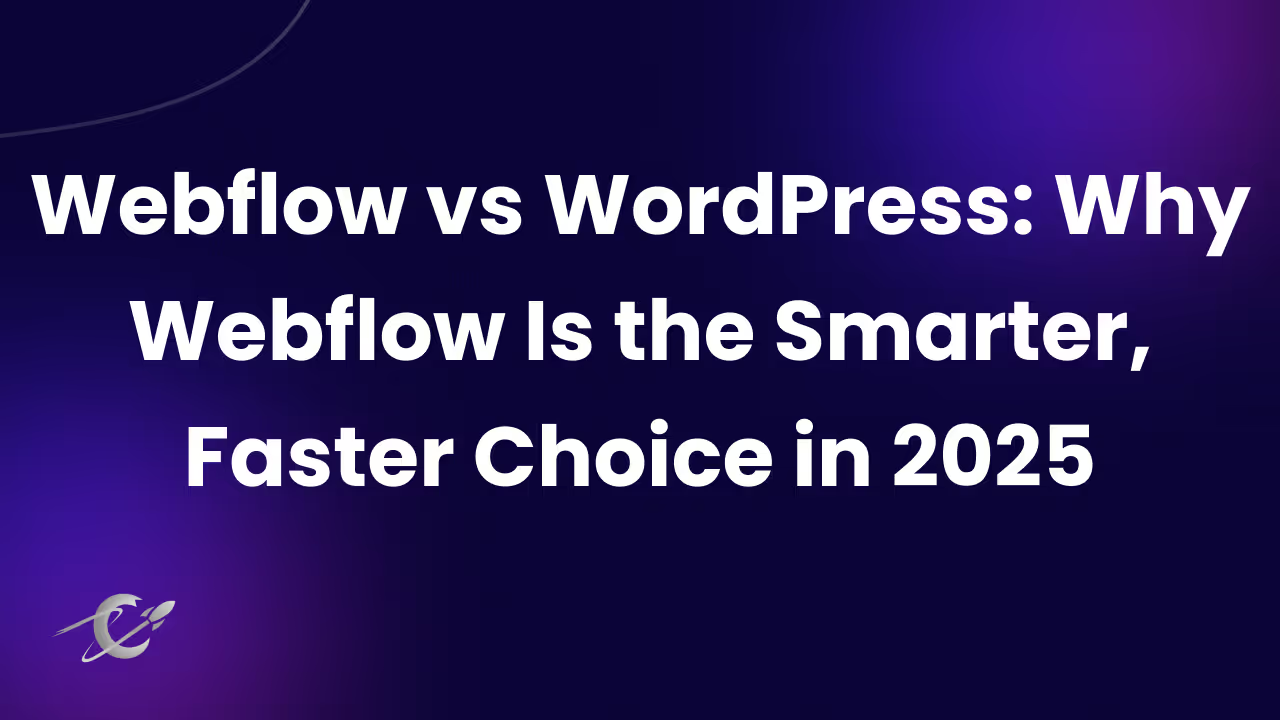
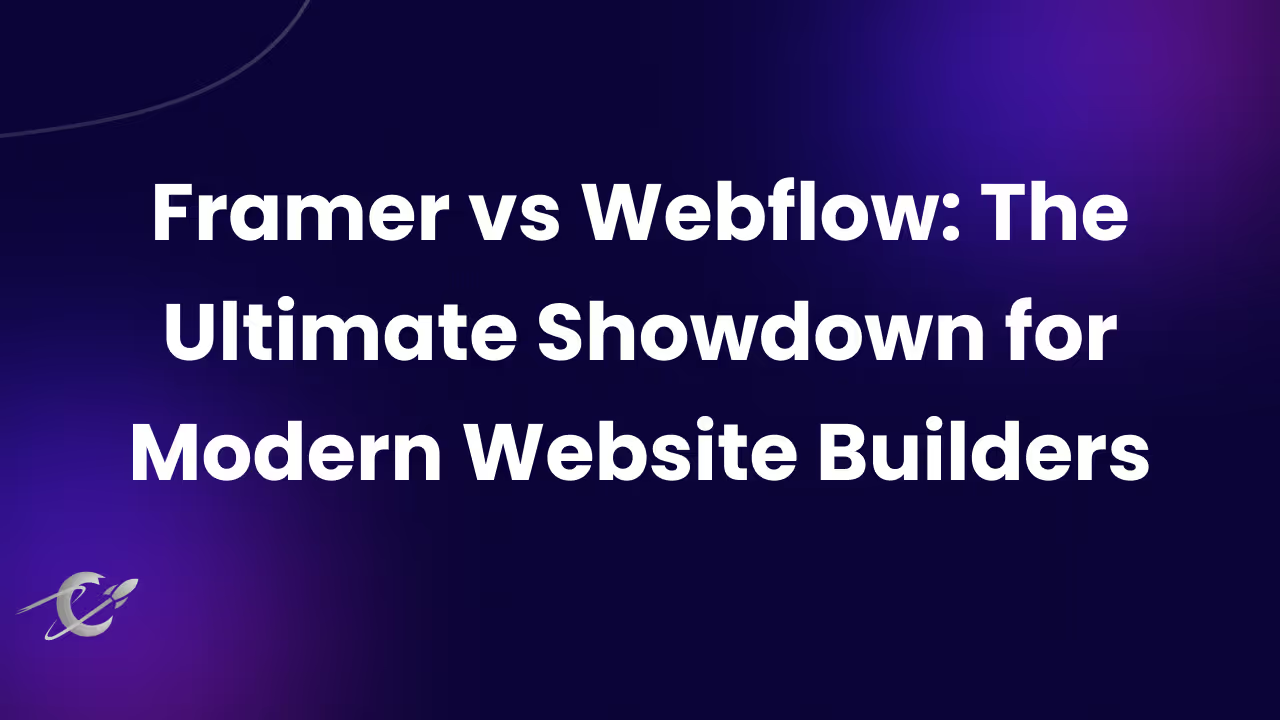
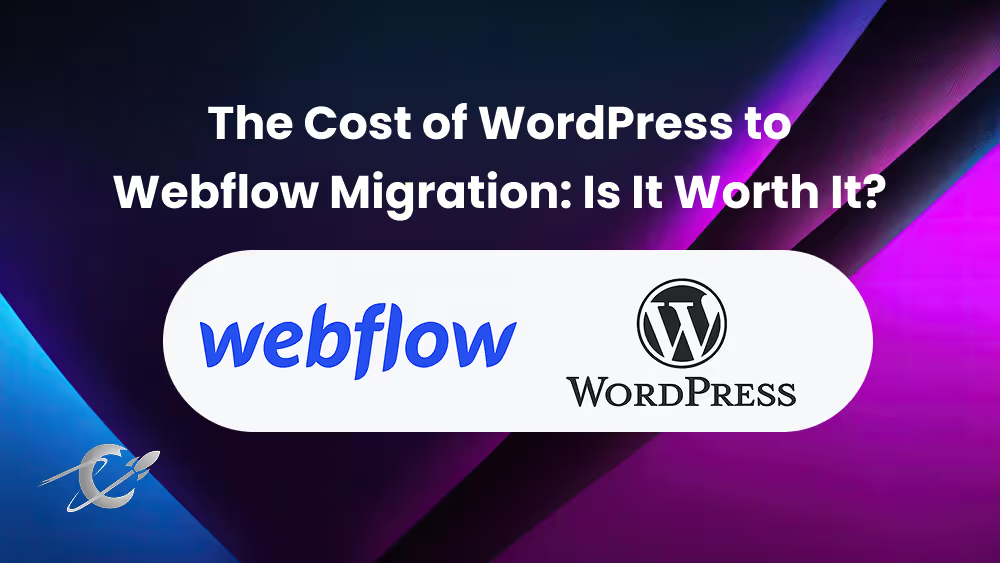
Only valid for-